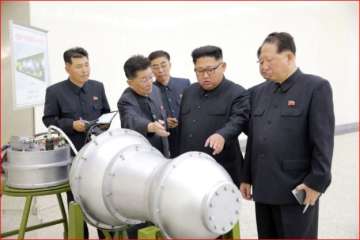North Korea’s ‘Hydrogen Bomb’: All about the thermonuclear device, its capacity, range and devastating power
North Korea claims to have tested 'Hydrogen bomb' that could be placed on an Intercontinental Ballistic Missile (ICBM).

North Korea, the hermit kingdom of Kim Jong-Un, on Sunday delivered yet another surprise to world community when it claimed to have successfully tested a ‘Hydrogen Bomb’ that could be placed on an Intercontinental Ballistic Missile (ICBM).
It was the sixth nuclear test by North Korea. However, it was different from its earlier tests as North Korea claimed to have detonated a different device this time that relied on nuclear fusion (Hydrogen bomb) instead of nuclear fission (Atom bomb).
So, what is the difference between an atom bomb and a Hydrogen bomb? And what is the capacity of the “Hydrogen bomb” that North Korea claims to have successfully tested on Sunday, especially in comparison to the bombs that the United States on the Japanese cities of Hiroshima and Nagasaki during World War- II?
An Atom bomb is a nuclear device that releases huge amounts of energy when atoms of radioactive materials such as uranium and plutonium split (nuclear fission). As a result of fission, their subatomic neutrons go free, leading to generation of a burst of heat radiation equivalent to the Einstein’s famous energy-mass formula (E=mc2).
A Hydrogen bomb (also called thermonuclear device), on the other hand, releases far greater energy using the process of nuclear fusion. The yield of a Hydrogen bomb can be 100 times higher compared to an atom bomb. It uses both fission and fusion — the fusing together of atomic nuclei — to produce more explosive energy and it's the same process that keeps the sun and other stars burning.
A Hydrogen bomb has thermonuclear fuel inside that can be ignited during the first stage, which is still powered by nuclear fission. These devices employ a second stage of reactions using nuclear fusion to basically magnify the destructive force of a typical atomic explosion. As the fusion of deuterium and tritium (types of hydrogen) occurs and atoms link together, they fire off neutrons to create even more destructive power in a chain reaction when they come in contact with the bomb’s uranium layer.
Though there is no unanimity over whether North Korea actually tested a complex device like “Hydrogen Bomb”, the scientists and officials agree that the yield of the device that North Korea tested on Sunday was much higher compared to its earlier nuclear devices.
According to these experts, the explosive yield of North Korea’s “Hydrogen bomb” was in the range of 50-120 kilotons TNT (Trinitrotoluene which is an explosive).
Norsar, a Norwegian geoscience research foundation, estimated the explosive yield of North Korean tested bomb to be at 120 kilotons TNT. However, South Korea's weather agency estimated the nuclear blast yield of the North Korean device between 50 and 60 kilotons TNT.
What cannot be overlooked is that even a yield of 50-120 kilotons TNT would be at least four-eight times higher than the energy released by the atom bombs that the United States dropped on the Japanese cities of Hiroshima and Nagasaki in 1945.
It should be recalled that the first atom bomb dropped by the US on Hiroshima on 6 August 1945, generated a blast equivalent to around 15,000 tons - or 15 kilotons of TNT. And the second atom bomb dropped on Nagasaki, three days later, had a force of around 20 kilotons of TNT. The two atom bombs combinedly killed around 200,000 people of the two Japanese cities.
The two bombs killed around 100,000 people in the two cities on the first day while the rest died in the following months from the effect of burns, radiation sickness, and other injuries, compounded by illness and malnutrition.